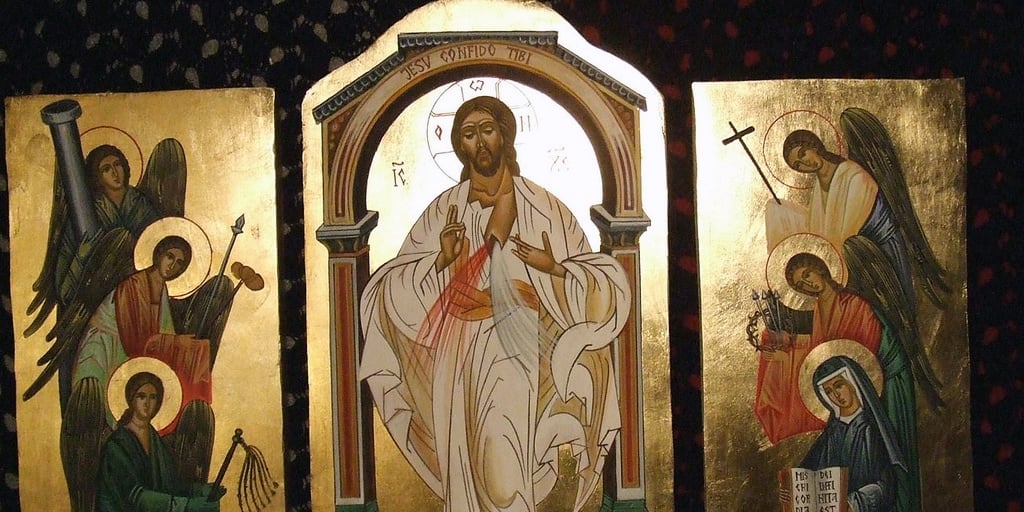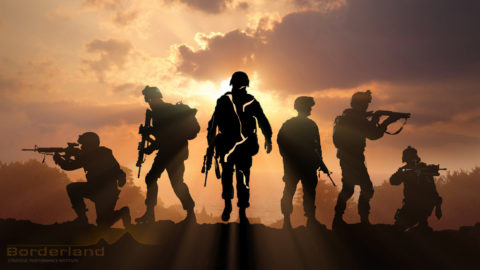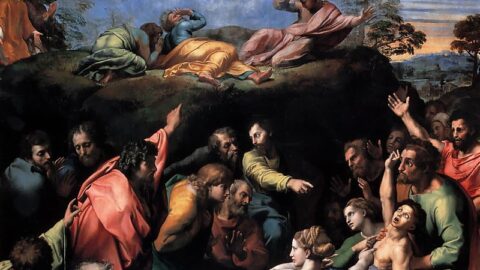The Blood, The Water, and The Spirit: Reflections on Low Sunday
By Borderland Nathan
1 John 5:4-10
4 For whatever is born of God overcomes the world; and this is the victory that overcomes the world, our faith. 5 Who is it that overcomes the world but he who believes that Jesus is the Son of God? 6 This is he who came by water and blood, Jesus Christ, not with the water only but with the water and the blood. 7 And the Spirit is the witness, because the Spirit is the truth. 8 There are three witnesses, the Spirit, the water, and the blood; and these three agree. 9 If we receive the testimony of men, the testimony of God is greater; for this is the testimony of God that he has borne witness to his Son. 10 He who believes in the Son of God has the testimony in himself. He who does not believe God has made him a liar, because he has not believed in the testimony that God has borne to his Son.
There is a flow in the readings today. The first is the belief in Jesus as the Son of God in order to overcome the external world. The second is that we receive that same Spirit that testified to Jesus. The third is that we move from old man to new, as a healed, unified whole in accordance with that Spirit. I will move from these points in order.
1. Belief in the Son of God
This passage is the one containing the controversial Comma Johanneum, or “Johanine comma.” In brief, this refers to a passage in 1 John 5:7-8 that many biblical scholars have argued was not part of the original text. It has been viewed as a clear teaching of Trinitarian theology. I will compare them side by side. Note how it reads in the RSV-CE, which is probably similar to whatever modern version you have.
1 John 5:7-8
7 And the Spirit is the witness, because the Spirit is the truth. 8 There are three witnesses, the Spirit, the water, and the blood; and these three agree.
Now see how this appeared in older Catholic Bibles that were based on the Latin Vulgate:
Johanine Comma
7 There are three who give testimony in heaven: the Father, the Word, and the Holy Spirit; and these three are one. 8 And there are three that give testimony on earth: the spirit, and the water, and the blood; and these three are one.”
There are many arguments against the Johanine comma being in the original text, as well as softer arguments against the “three that testimony on earth” portion in verse 8. The main arguments against the comma are that no Greek manuscript contains them until the 15th century, and the main arguments for them are that the Latin fathers of the church refer to it in their writings quite early, and that the theology is correct.
The question for a Catholic is not whether the text is original to the document, but whether it is original and faithful to Church tradition and teaching. This would make it original in the sense that matters, in the same way that the passage in John about the adulteress woman is a true event, but probably wasn’t originally in John (There is some evidence that it was included in the gospel of Luke). This is irrelevant for us, since the Church recognized the event and teaching as true, and so included it in the canon of Scripture. Something is not true because it happened in Scripture. Rather, it is true because it happened, and Scripture is a witness to it, the same as are the Church and Tradition, and all three witness toward each other. The Bible came out of the Church, not vice versa, and the Church recognizes and transmits Scripture. This is very different from the protestant perspective, which depends exclusively on the text to be completely free from error, lest the entire denomination believe an error. This is very difficult to to adhere to, considering all the different manuscripts and translations that exist across the world in the various churches. A Catholic does not have this problem. In that spirit, I will refer to the Johanine comma as well as the part about witnesses on Earth as legitimate to flesh out Church teaching, particularly when it comes to the liturgical significance.
In ancient Jewish thought, there was a concept where two or three witnesses were required for legal testimony to be considered valid.1)Deuteronomy 19:15. As always, the disciple John was arguing within a Jewish framework. This should not be surprising, when we consider how perfectly Jesus kept the Jewish Law before transcending it. Jesus, as the Word in the Trinitarian God, is a self-witness. God simply is. We cannot hold him to account, or judge him by earthly standards, or say that he is not true. He is the standard of all truth, and even in his Trinitarian being do we see a threefold witness to Jesus that fulfills the Jewish criterion for proof. It’s a bit like the math problem 1+1+1=3. You don’t have to say “prove it,” in the sense of a longer math problem that needs to be worked out in a series steps. Rather, it is grasped as true immediately, as soon as you see what it is, and all the different numbers in it are part of that truth.
In the text without the Johanine Comma, we have the Spirit, the water, and the blood. The Church father Eusebius wrote of a proto-Docetist named Cerinthus. This heretic attempted to write forgeries and pass them off as the writings of Saint John, who despised him so much that Eusebius says he would not even enter the same bath house as him.2)Eusebius, An Ecclesiastical History to the Twentieth Year of the Reign of Constantine, trans. C. F. Crusé (London: Samuel Bagster and Sons, 1847), chap. 28, 131-132. Cerinthius believed that Jesus became the Son of God in baptism as a form of adoption, but he did not actually die on the cross.3)Daniel R. Streett, They Went Out from Us: The Identity of the Opponents in First John, vol. 177 (Berlin: De Gruyter, 2011), 276. There is good reason to think that Saint John’s writings are meant to directly combat these heresies. This is why he talks about not just the baptism of Jesus as a witness in the water, but also the death of Jesus as a witness in the blood. Remember that it was Saint John who recorded the detail about water and blood spraying from Jesus’s side when the Roman soldier pierced him with a lance. The counter argument that Saint John is making against Cerinthus is that no, both the baptism and the cross are bookends of Christ’s Sonship. He was truly God, but also truly man.
![]()
As commentator Lapide has noted, citing Salmeron, Jesus always gave blood mixed with water. The water of his tears with the blood of his circumcision; the water of his sweat with blood in the Garden of Gethsemane; the water and blood from his side on the cross.4)Cornelius À Lapide, The Great Commentary of Cornelius À Lapide: S. John’s Gospel, Chaps. 12–21 and Epistles 1, 2, and 3, trans. William Frederick Geikie-Cobb, 4th ed. (Edinburgh: John Grant, 1908), 474.
Water and the blood of animals ratified the Old Testament under Moses, and water and blood ratified the New Testament under Christ. Water sluiced the blood of the sacrifices down the drains of the Jewish Temple and into the Kidron valley, and our priests mix water with blood when preparing the holy Eucharist.5)John Bergsma, Jesus and the Dead Sea Scrolls: Revealing the Jewish Roots of Christianity (New York: Image, 2019), 65.
Belief is at the core of this passage in John. Belief, and witness. In John’s view, Christ’s death in particular is the witness. Likewise, Saint Paul preaches Christ crucified. Even the word martyr comes from the Greek word martus, meaning “witness,” and so there is a particular emphasis on death as being a form of testimony. As a former protestant, this did not make as much sense in my worldview. Our focus in my particular denomination was on the resurrected Christ. “He is risen,” my mother used to say, in a way calculated to show disdain toward the Catholic crucifix. And yet this isn’t what Saint John says, and it most certainly isn’t what Saint Paul chose to focus on.
Jesus’s death in particular was what witnessed to him, and this makes sense when you consider Saint John’s theology of Jesus as the new Passover lamb. The lamb had to die. Without this, there was no atonement for sin, and death would not pass over your household. Further, if Jesus was Divine, rising from the dead is not as much of a miracle as the act of dying itself. We often think of the resurrection as a testament to his deity, and yet he already acted as God through miracles and other means. The question, along with the accusations of Cerinthus, was whether Jesus could die, and even serve as our sacrificial lamb. And so, we as Catholics preach Christ crucified along with Saint Paul.
1 Corinthians 1:22-24
22 For Jews demand signs and Greeks seek wisdom, 23 but we preach Christ crucified, a stumbling block to Jews and folly to Gentiles, 24 but to those who are called, both Jews and Greeks, Christ the power of God and the wisdom of God.
There also is a twofold aspect to this witness, that seems to correspond to a more and less perfect form of testimony. God attests to himself because he simply “Is.” He is the ground of all truth. “I am.” And yet people doubt his existence, even while looking at creation. And so out of creation God crafts signs that point toward heavenly realities; signs such as the Spirit, the water and the blood.

John 20:19-31
19 On the evening of that day, the first day of the week, the doors being shut where the disciples were, for fear of the Jews, Jesus came and stood among them and said to them, “Peace be with you.” 20 When he had said this, he showed them his hands and his side. Then the disciples were glad when they saw the Lord. 21 Jesus said to them again, “Peace be with you. As the Father has sent me, even so I send you.” 22 And when he had said this, he breathed on them, and said to them, “Receive the Holy Spirit. 23 If you forgive the sins of any, they are forgiven; if you retain the sins of any, they are retained.”
24 Now Thomas, one of the twelve, called the Twin, was not with them when Jesus came. 25 So the other disciples told him, “We have seen the Lord.” But he said to them, “Unless I see in his hands the print of the nails, and place my finger in the mark of the nails, and place my hand in his side, I will not believe.”
26 Eight days later, his disciples were again in the house, and Thomas was with them. The doors were shut, but Jesus came and stood among them, and said, “Peace be with you.” 27 Then he said to Thomas, “Put your finger here, and see my hands; and put out your hand, and place it in my side; do not be faithless, but believing.” 28 Thomas answered him, “My Lord and my God!” 29 Jesus said to him, “Have you believed because you have seen me? Blessed are those who have not seen and yet believe.”
30 Now Jesus did many other signs in the presence of the disciples, which are not written in this book; 31 but these are written that you may believe that Jesus is the Christ, the Son of God, and that believing you may have life in his name.
2. Receive the Spirit
A strange thing happens in this passage. Jesus shows up after he died, and immediately breathes the Holy Spirit into them for the purpose of forgiving and retaining sins. I have often taken this passage for granted but when you actually think about it, why does he do that? Why does he choose only forgiving sins? I can think of any number of graces or abilities that the disciples would need, such as the gifts given later during Pentecost. Gifts for teaching, preaching, and evangelization. Why would Jesus appear to them in a locked room, and breathe the ability to forgive and retain sins into them first?
First we should note how radical this is. God alone forgives sins:
Luke 5:20-24
20 And when he saw their faith he said, “Man, your sins are forgiven you.” 21 And the scribes and the Pharisees began to question, saying, “Who is this that speaks blasphemies? Who can forgive sins but God only?” 22 When Jesus perceived their questionings, he answered them, “Why do you question in your hearts? 23 Which is easier, to say, ‘Your sins are forgiven you,’ or to say, ‘Rise and walk’? 24 But that you may know that the Son of man has authority on earth to forgive sins”—he said to the man who was paralyzed—“I say to you, rise, take up your bed and go home.”
The pharisees were not wrong. Who alone indeed, but God, could forgive sins? And then Jesus turns around and does just that. In Jewish thought, many times sin and sickness were tied together. Jesus alludes to this by equating the man’s paralysis with his sinful state, and then showing that by healing him his sins are forgiven, and by forgiving his sins he is healed. This is key: The healing of the man is a sign so that you may know who the Son of Man is: God. Because only God can do that. And God would never endorse the blasphemy of a man attempting to forgive sins in his name. Since God would not endorse blasphemy, Jesus has his testimony in this action as that of being God.
If we return back to the passage in the Gospel of John, Jesus appears to the believing apostles and simply attests to himself. He gives no explanation for the authority of what he is doing; he gives them the power to act in his name, since he is God. This is akin to the first level of testimony, where it is God in himself that testifies by simply being. But when he goes to see our Doubting Thomas, what does he do? He appeals to a more earthly sign pointing to the heavenly reality: He points to his wounds. The wounds where the blood and the water came forth. The wounds he bore on the cross when the Roman centurion proclaimed him the Son of God.
Notice that even now, against my formerly protestant sensibilities, Jesus did not point to his resurrection as testimony. He pointed to his blood. Everywhere in John’s Gospel you will see the Spirit, the water, and the blood in close proximity.
To understand the meaning of the forgiveness of sins, we need to look at the presence of the Holy Spirit, as well as the immediate context. Jesus gave the Spirit to the apostles more than once, in gradually broader spheres of responsibility and influence. In Matthew 10:1, Jesus sent out the disciples in his name before his crucifixion and under his authority. They were performing works of the Kingdom by the Spirit, but had not received the Spirit. This was a pedagogical action, which like a good teaching lesson was designed to prepare them for John 20:21. There we move to Jesus breathing the Spirit into them, giving them the power to forgive and retain sins, and giving private witness in a private setting between apostles. Finally we have Pentecost in Acts 2, where there is a public witness and a public outpouring of the Spirit for the purpose of external evangelization.
This move from trial run, to internal institution, to external global witness, should form the backdrop of how we understand why Jesus focused on the forgiveness of sins. Now we can zoom in and consider the immediate setting in John. They are in fear in a locked room. They are scared of the Jews, and Peter had denied Jesus three times earlier in the Gospel. We have external persecution, and internal fracture. All of the apostles were not even present, with Thomas missing. Jesus then mentions two things: Peace, and forgiveness of sins through the Holy Spirit.
After appearing to Thomas, he later appears to Peter, and three times asks Peter if he loves him, to undo the three-part betrayal during his Passion. He then tells him how he will die, which we know through tradition was by being crucified upside down. We have Jesus giving the institution of confession in the locked room, and then later showing exactly how this takes place. He reinstated Peter, but also gave penance. Peter had denied the Lord, and he would be martyred. He had to believe in the Lord again so that he could overcome the world.
We do not see that Jesus re-breathed the Spirit into Thomas since he was not present in the locked room. Rather, he gave the power to forgive and restore to the body of apostles. To take part in the power of the body means to be grafted back into the body through forgiveness, the same way that the disciples take part in the power of the keys given to Saint Peter by being in communion with him.
3. A New Man of Peace and Unity
Now, as then, confession brings peace, even with the presence of external threats. Before we move externally and face the world we must heal our internal rifts, as Christ brought Peter and Thomas back into the fold. Likewise a husband must heal any rift between he and his wife, and his children between their mother, and brothers with their sisters. As Jesus said elsewhere:
Matthew 5:23-24
23 So if you are offering your gift at the altar, and there remember that your brother has something against you, 24 leave your gift there before the altar and go; first be reconciled to your brother, and then come and offer your gift.
And as James says:
James 5:16
16 Therefore confess your sins to one another, and pray for one another, that you may be healed. The prayer of a righteous man has great power in its effects.
Notice that there is an order to how we approach our spiritual life, both as individuals and a community. First we must have peace, and be reconciled to God and to one another. Only then can we receive the graces necessary to witness to the world. A divided house cannot stand, and the Holy Spirit is a Spirit of unity, not division. As Jesus himself said, this unity and healing must exist before we take part in worship, lest as Saint Paul said, we profane the body and blood of God by destroying the unity of his one body with our own sinful disunity.
The disciples were hurting. It says something about the skepticism and state of Thomas that he wasn’t even there with them. Peter was hurting. He jumped into the ocean when he saw Jesus after the crucifixion. Think about the guilt and the grief a fisherman must feel after he had betrayed a friend. That reaction, jumping into the sea, says it all. Also see that Peter did not let his guilt keep him from approaching his God. The sin of presumption is a real thing; we can believe that we do not deserve God’s forgiveness. Peter had no such illusions. Of course he didn’t deserve it, so why not dive toward his Lord? What is there to lose at that point? He had already lost him. There could be only gain. His heart was with Jesus. But it needed to be healed first. And then, after his confession and in his penance, Peter would “witness” to the world through his own sign of blood: his crucifixion.

Colossians 3:1-17
If then you have been raised with Christ, seek the things that are above, where Christ is, seated at the right hand of God. 2 Set your minds on things that are above, not on things that are on earth. 3 For you have died, and your life is hid with Christ in God. 4 When Christ who is our life appears, then you also will appear with him in glory.
5 Put to death therefore what is earthly in you: immorality, impurity, passion, evil desire, and covetousness, which is idolatry. 6 On account of these the wrath of God is coming. 7 In these you once walked, when you lived in them. 8 But now put them all away: anger, wrath, malice, slander, and foul talk from your mouth. 9 Do not lie to one another, seeing that you have put off the old nature with its practices 10 and have put on the new nature, which is being renewed in knowledge after the image of its creator. 11 Here there cannot be Greek and Jew, circumcised and uncircumcised, barbarian, Scyth′ian, slave, free man, but Christ is all, and in all.
12 Put on then, as God’s chosen ones, holy and beloved, compassion, kindness, lowliness, meekness, and patience, 13 forbearing one another and, if one has a complaint against another, forgiving each other; as the Lord has forgiven you, so you also must forgive. 14 And above all these put on love, which binds everything together in perfect harmony. 15 And let the peace of Christ rule in your hearts, to which indeed you were called in the one body. And be thankful. 16 Let the word of Christ dwell in you richly, as you teach and admonish one another in all wisdom, and as you sing psalms and hymns and spiritual songs with thankfulness in your hearts to God. 17 And whatever you do, in word or deed, do everything in the name of the Lord Jesus, giving thanks to God the Father through him.
You’ve been born into Christ, but a risen Christ. The apostles received the Spirit after the resurrection, not before. A dead-then-risen Christ implies a dead-then-risen nature from flesh to spirit, from a Spirit of division to one of unity and divine simplicity. There is now neither Jew nor Greek. What divides us? Consider not just natural distinctions like race or gender, but constructed ones. If we do not recognize distinctions between us and can’t find a reason to fight, human nature is to try and make one. We love drama. We create division through our broken relationships and sin. Remember that disputed verse in the Vulgate of 1 John 5:8? Let’s take a look at it one more time.
1 John 5:8
8 And there are three that give testimony on earth: the spirit, and the water, and the blood; and these three are one.”
In the gospels, if you remember how when Jesus died, there was a Roman soldier that said “Truly this was the Son of God.”
Mark 15:37-39
37 And Jesus uttered a loud cry, and breathed his last. 38 And the curtain of the temple was torn in two, from top to bottom. 39 And when the centurion, who stood facing him, saw that he thus breathed his last, he said, “Truly this man was the Son of God!”
This may have struck you as somewhat strange, as it did me. After all, it isn’t particularly unusual for a man that is nailed to a board to eventually die. Other events happened such as the Temple veil tearing and an earthquake, but in the immediate context the soldier is right by the cross and so it wouldn’t have been these events that made him say it in this moment. But this centurion was the same one that stabbed Jesus in the side with a spear, and his name was Longinus. He was was nearly blind, and as he pierced our Lord, the blood and water sprayed from Jesus’s heart into his eyes and healed his sight. His first appearance by name was in the gospel of Nicodemus, and his legend grew over the years. But he is recognized as a saint and later a martyr in both the East and the West. There are some who view us as having gotten his tradition from a fake gospel, but the truth is rather that the event really happened, and was recorded by both false and true writings and traditions.
We do not receive our Tradition from texts, but rather from true events. The gospel of Nicodemus not being considered canonical does not mean that the name of the soldier was not true. The fact that both the East and the West recognize the same true elements is a testament, not to the Gospel of Nicodemus, but rather to the real man that pierced the side of Christ and had his life forever changed. In the same way, we did not get the upside down crucifixion of Saint Peter from the apocryphal writings on Peter, but rather from the real event, which left the crucified remains of a powerfully built old man buried in Rome, wrapped in royal purple and gold-threaded cloth. The peculiar fact that the bones are completely missing the footbones from the ankles down doesn’t prove that he was crucified upside down, but it does fit the idea that the Romans merely chopped his legs at the ankles to get him off the cross.6)See John Evangelist Walsh, The Bones of St. Peter: The First Full Account of the Search for the Apostle’s Tomb (Garden City, NY: Doubleday, 1982), ch. 10. It is fitting, then, that in keeping with this reflection on witnesses, Longinus was himself martyred. The blood, water, and Spirit witnessed for Christ by healing a soldier’s sight. Longinus then witnessed twice to Jesus being the Son of God, both at the cross and at his own decapitation.

Just as Longinus bore witness by the sacramental water and blood, we bear witness in our own lives. The Fathers saw the Spirit, water, and blood as being present in the sacraments. Baptism is water, linked to the death of Christ, and with the infusing of the Spirit. The Eucharist is the blood of Christ. The Spirit is present in both. These earthly signs continue to witness to the Church itself, even as Jesus was recognized in the breaking of the bread in the Gospel of Luke, which I have spoken on elsewhere. As a Christian we always strive for unity, and this unity is found in the peace and healing of confession. God can make you new; he can put Humpty Dumpty back together again. He can fix what is broken. But as a symbol of unity, we go to confession and are reconciled to each other and our God before we approach the Eucharist. And then we walk out the doors of our parish and witness to the outside world, just as Saints Peter and Longinus were both healed, and then went forward to the outside world as new men in the Spirit.

Saint Longinus, A.D. 1st Century
References










 Rob Brotzman
Rob Brotzman  Nathan Wagar
Nathan Wagar